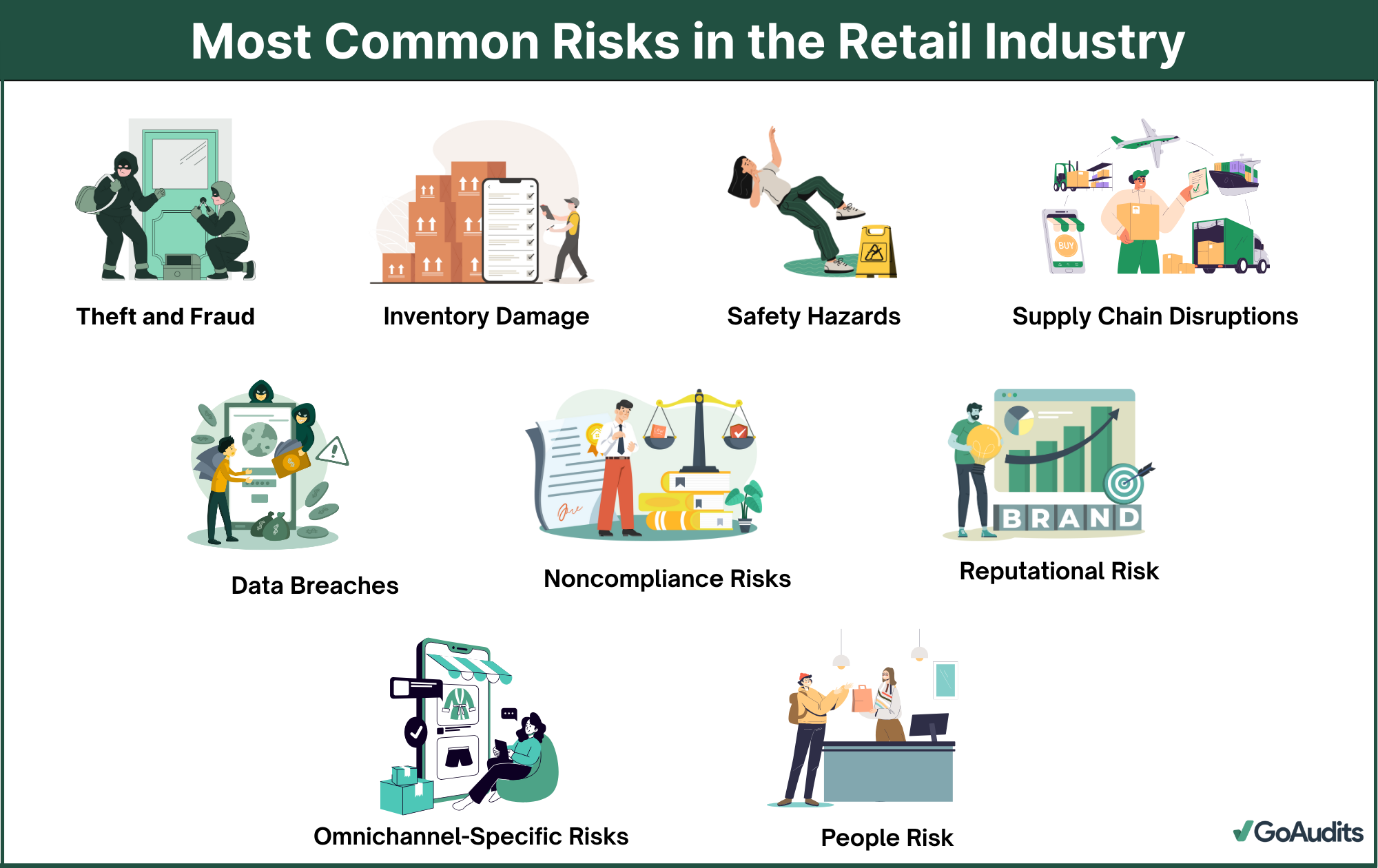Key Takeaways
- Effective retail risk management helps safeguard revenue, ensure compliance, and maintain customer trust.
- Often, retailers struggle to track and consistently address these risks across multiple locations.
- A retail audit software streamlines risk assessment and control through inspections, instant reporting, and actionable insights.
Risks in retail can impact profit margins, brand reputation, and even business survival. According to the National Retail Federation (NRF), U.S. retailers alone lost an estimated $112.1 billion to shrinkage in 2022, largely due to theft, fraud, and process failures. Meanwhile, the average cost of a retail data breach increased by 18% to $3.48 million in 2024, as reported by IBM.
Read on to know the importance of systematic risk assessment, the unique risks faced by retail stores, and how an audit software like GoAudits can help transform reactive retail risk management into a proactive, data-driven process that protects both your bottom line and your brand.
What is Risk Management in the Retail Industry?
Risk management in the retail industry is a systematic process that involves identifying, assessing, and controlling threats to a retailer’s capital and earnings. These threats, or risks, can stem from a wide variety of sources, including financial uncertainties, legal liabilities, operational errors, accidents, and natural disasters. In the section below, we will review the most common types of risks that retailers face.
Effective retail risk management enables you to make informed business decisions, safeguard your assets, and create a safer, more secure environment for both your employees and customers.
Why Risk Management is Important in Retail
A structured approach to risk management in the retail industry is critical for the following reasons:
- Enhanced Security: A secure environment boosts staff morale and shopper confidence. It creates a stable foundation for all your retail store operations.
- Increased Operational Efficiency: The process of identifying retail risks often shows operational bottlenecks and inefficiencies. By streamlining processes to reduce risk, you naturally make your operations leaner, faster, and more cost-effective.
- Improved Retail Compliance: Retailers must comply with an array of regulations, from health and safety standards (OSHA) to Payment Card Industry Data Security Standards (PCI DSS). A formal retail risk management process ensures you stay on top of these regulations, avoiding fines, penalties, and legal trouble.
- Protecting Brand Reputation and Customer Trust: In the age of social media, reputation is everything. A data breach, a major safety incident, or a product recall can shatter customer trust instantly. Effective risk management is your best defense for protecting your brand image.
- Secure Financial Stability: Every risk has a potential financial impact. Shoplifting hits your bottom line, supply chain disruptions halt sales, and safety violations lead to costly lawsuits. By mitigating risks, you protect your revenue, control costs, and ensure the financial health of your business.
Most Common Risks in the Retail Industry to Watch Out For
While every business is unique, most face similar types of risks and threats in the retail business. Here are the key retail risks you need to have on your radar:
Theft and Fraud
This is often the first risk that comes to mind and includes shoplifting, employee theft (internal theft), return fraud, and vendor fraud. These seemingly small incidents can cause significant annual losses, a phenomenon known as “shrinkage.”
Inventory Damage
Your stock is one of your most valuable assets. It can be damaged due to improper handling, poor storage conditions (e.g., pests, leaks), expired shelf life, or accidents, rendering it unsellable.
Safety Hazards
Slips, trips, and falls are among the most common in-store accidents, posing a risk to both staff and customers. Other retail hazards include falling objects, faulty equipment, fire hazards, and manual handling injuries, all of which can lead to workers’ compensation claims and lawsuits.
Supply Chain Disruptions
Modern supply chains are long and complex, making them vulnerable. Delays from suppliers, transportation issues, geopolitical events, or natural disasters can lead to stockouts, lost sales, and unhappy customers.
Data Breaches and Cybersecurity Risks
Retailers collect vast amounts of sensitive customer data, from personal details to credit card information. A data breach can be catastrophic, leading to massive fines, legal fees, and a complete loss of customer trust. Phishing attacks, ransomware, and POS malware are all serious threats.

Noncompliance and Legal Risks
Failing to comply with local, national, and international laws is a major risk. This includes labor laws, health and safety regulations, consumer protection laws, and data privacy acts like GDPR or CCPA.
Reputational Risk
Negative publicity, poor customer reviews, unethical sourcing practices, or a misjudged marketing campaign can quickly tarnish your brand. Bad news travels fast and can have a lasting impact on customer loyalty.
Omnichannel-Specific Risks
Operating both online and in brick-and-mortar stores creates unique challenges. Retail risks include inventory synchronization issues between channels (selling items online that are out of stock in-store), complexities in cross-channel returns, and ensuring a consistent and secure customer experience everywhere.
People Risk
Your employees are your greatest asset, but they can also be a source of risk. This includes everything from high employee turnover and lack of training to internal misconduct or a simple human error that leads to a major operational failure.
How to Implement Effective Risk Management in a Retail Business
Here’s a step-by-step risk management plan for retail stores, along with software solutions and free resources:
Step 1: Identify Risks in Your Retail Business
Identify potential threats across your entire operation. Audit every department, process, and location. To do this effectively, move beyond simple guesswork. Implement a systematic approach that involves:
- Brainstorming with your team from different departments (store floor, warehouse, IT, finance).
- Conducting physical inspections of your premises.
- Analyzing historical data on incidents, losses, and near misses.
Require your team to use digital retail audit checklists to gather risk data. Create templates for every area of your business, from daily store operations to warehouse safety checks. These checklists facilitate comprehensive data collection with photos, notes, comments, and location capture to provide rich, on-the-ground context for every potential risk.
Here are free retail risk management checklist templates to help you get started:
- Retail Store Inspection Checklist
- Loss Prevention Audit Checklist
- Store Maintenance Checklist
- Inventory Audit Checklist
- Store Safety Checklist
Step 2: Assess and Prioritize Risks
Once you have a list of identified risks, determine which ones need your immediate attention. This is done by assessing each risk based on two key factors:
- Likelihood: How likely is this risk to occur?
- Impact: If it does occur, how severe would the consequences be for your business?
Plot these on a simple risk matrix to categorize them as low, medium, high, or critical. A high-impact, high-likelihood risk (like a lack of security cameras in a high-theft area) should be a top priority over a low-impact, low-likelihood risk (like a brief power outage in a store with a backup generator).
Step 3: Create Strategies to Mitigate the Risks
The goal is to reduce either the likelihood or the impact of the risk, or both. To develop the most effective strategies, you need data-driven insights.
Analyze findings from across all your locations, along with historical data, to spot patterns and recurring problems. Use an effective retail audit software like GoAudits. It comes with built-in analytics and powerful inspection reporting features to help you identify trends and address the root cause of an issue, not just its symptoms.
Case Study: How Goodwill leverages GoAudits to streamline communication and operations across 100+ locations.
Step 4: Implement Risk Controls for Compliance and Security
These measures are related to specific policies, procedures, and actions to reduce your risks and can include installing security systems, training staff on safety protocols, developing an incident response plan, or updating your data encryption.
When an issue is found during an inspection, you must track its resolution to the T. With GoAudits, you can instantly assign a task to the right person or department, or even a third party (like a vendor), set a clear deadline, and track the issue through to resolution.
Step 5: Monitor and Review for Continuous Improvement
The retail environment, technology, and regulations are always changing, so your risks will evolve too. You must regularly monitor your controls to see if they are working and review your risk assessment to identify new threats.
Make regular store audits and inspections a core part of your operations. Scheduling and conducting consistent audits with a platform like GoAudits ensures that your risk controls remain effective, your standards are being upheld across all locations, and your business is always prepared for the next challenge.
Implement Effective Operational Risk Management in Retail With GoAudits
Audits and risk assessments in retail are great tools to empower your store business. Thus, many retailers leverage GoAudits retail audit software to streamline their operations, audit, and risk management processes.
For example, after testing in one of their divisions, the Goodwill team rolled out GoAudits to five additional divisions. The company saves at least 20 hours/week, estimating a direct annual savings of $20,000.
With GoAudits, you can:
- Establish brand consistency and reputation.
- Deliver top-notch services to customers, regardless of the store they visit.
- Assess the effectiveness of merchandising and planograms.
- Facilitate retail communication between HQ and store teams.
- Enhance health and safety standards in your stores.
- Highlight problems and high-performing stores.
With a rating of 4.8 stars on Capterra, GoAudits is trusted by some of the biggest names in the retail industry.
» GoAudits Reviews: Read how companies leverage GoAudits to improve operational consistency and achieve brand standards.
FAQs
The greatest risk for a retail store is loss of revenue due to theft, both external theft (shoplifting) and internal theft (employee theft), which can significantly impact profit margins and inventory accuracy.
From a health and safety perspective, the top three physical hazards in a typical retail environment are slips, trips, and falls, manual handling injuries, and fire hazards.



